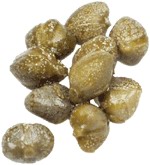Okra

English: lady’s fingers, gumbo
Arabic: bamya
French: gombo, okra, ketmie comestible
Italian: ibisco, frutto d’ibisco, gombo, gombro, ocra
Portuguese: quiabo, gombro, quingombo
Spanish: gombo, ocra, chaucha turca, quimgombף
Matza

A traditional Jewish unleavened bread baked in thin sheets made for Passover. In addition to being a Passover food, matzot can be served as an appetizer or snack.
Recipes
Corn

Nutritionally speaking:
The carbohydrate content of corn varies from type to type. Corn contains folic acid, potassium, and thiamine, as well as magnesium and some Vitamin C. It is a good source of fiber.
*** When boiling corn, don't salt the water, or the kernels will harden and lose their rich flavor.
Caffeine
An organic compound that is found in various foods and acts as a stimulant in the human body. Caffeine is found most commonly in coffee, tea, and chocolate.
must... have...
Caffeine Molecule
You live and code by this alkaloid,
why not wear your badge of addiction for all to see?

www.thinkgeek.com
must... have...
more... caffeine...
Caffeine Molecule
You live and code by this alkaloid,
why not wear your badge of addiction for all to see?

www.thinkgeek.com
Cabbage
 The origin of the English word cabbage is the Latin caput, which means "head." Cabbage is one of the most ancient vegetables, with evidence of its cultivation dating back more than 4000 years.
The origin of the English word cabbage is the Latin caput, which means "head." Cabbage is one of the most ancient vegetables, with evidence of its cultivation dating back more than 4000 years.People with little else to eat became reliant on the sturdy cabbage for their winter survival, and it thus because known as a "poor person's vegetable." But that doesn't mean cabbage is only for the economically-challenged! Centuries of cultivation have led to a virtual family tree of cabbage relatives, including kale, broccoli, cauliflower, and Brussels sprouts, and all of them are terrifically healthy and worth remembering to eat on a regular basis.


Red cabbage goes well with apples, onions, nuts, and red wine, and it makes an excellent bed for duck, and salmon.
Choose firm, shiny heads that are as dark as possible.
Don't overcook red cabbage or you'll sacrifice flavor and vitamins.
Note: You may have noticed that it turns blue, sometimes, when you cook it. That would be caused by the presence of any alkaline substance (like the lime in tap water, for example). If this discoloration tends to happen when you cook red cabbage, and you would prefer that it keep its original color, add some type of acid, like vinegar, to its cooking liquid.
Nutritionally Speaking:
Cabbage is a member of the Brasscia family, also called the cruciferous vegetable family, all members of which contain certain strong phytochemicals that are thought to be protective of good health and a shield against some cancers.
Caper
 [ KAY-per ] The flower bud of a bush native to the Mediterranean and parts of Asia. The small buds are picked, sun-dried and then pickled in a vinegar BRINE. Capers range in size from the petite nonpareil variety from southern France (less than 1cm diameter, considered the finest), to those from Italy, which can be as large as the tip of your little finger. There are also the Spanish-imported stemmed caperberries that are about the size of a cocktail olive. Capers are generally packed in brine but can also be found salted and sold in bulk. Capers should be rinsed before using to remove excess salt.
[ KAY-per ] The flower bud of a bush native to the Mediterranean and parts of Asia. The small buds are picked, sun-dried and then pickled in a vinegar BRINE. Capers range in size from the petite nonpareil variety from southern France (less than 1cm diameter, considered the finest), to those from Italy, which can be as large as the tip of your little finger. There are also the Spanish-imported stemmed caperberries that are about the size of a cocktail olive. Capers are generally packed in brine but can also be found salted and sold in bulk. Capers should be rinsed before using to remove excess salt. The pungent flavor of capers lends piquancy to many sauces and condiments, pizza, fish, meats and salads; they're also used as a garnish for meat and vegetable dishes. The flavor of caper may be described as being similar to that of mustard and black pepper. In fact, the caper strong flavor comes from mustard oil: methyl isothiocyanate (released from glucocapparin molecules) arising from crushed plant tissues.
Medicinal Uses
Capers are said to reduce flatulence and to be anti-rheumatic in effect. In ayurvedeic medicine capers (Capers=Himsra) are recorded as hepatic stimulants and protectors, improving liver function. Capers have reported uses for arteriosclerosis, as diuretics, kidney disinfectants, vermifuges and tonics. Infusions and decoctions from caper root bark have been traditionally used for dropsy, anemia, arthritis and gout. Capers contain considerable amounts of the anti-oxidant bioflavinoid rutin.
Arabic ??? ????? Kabar
French C?pre, Fabagelle, Tapana
Hebrew צלף קוצני Tsalaf kotsani
Italian Cappero
Portuguese Alcaparras
Spanish Alcaparra, Caparra, T?pana; Alcaparr?n (caper berries)
*** The prefix al- in Iberic names (Portuguese alcaparra “caper”, Spanish alcaparr?n “caper berry”) indicates that these names are not simply inherited from Latin, but have been reloaned from Arabic al-kabara [?????] “the caper”, where the article al has been interpreted as part of the word and thus included into the loan word. In last consequence, Arabic kabara [???] is, of course, related to Latin capparis.






